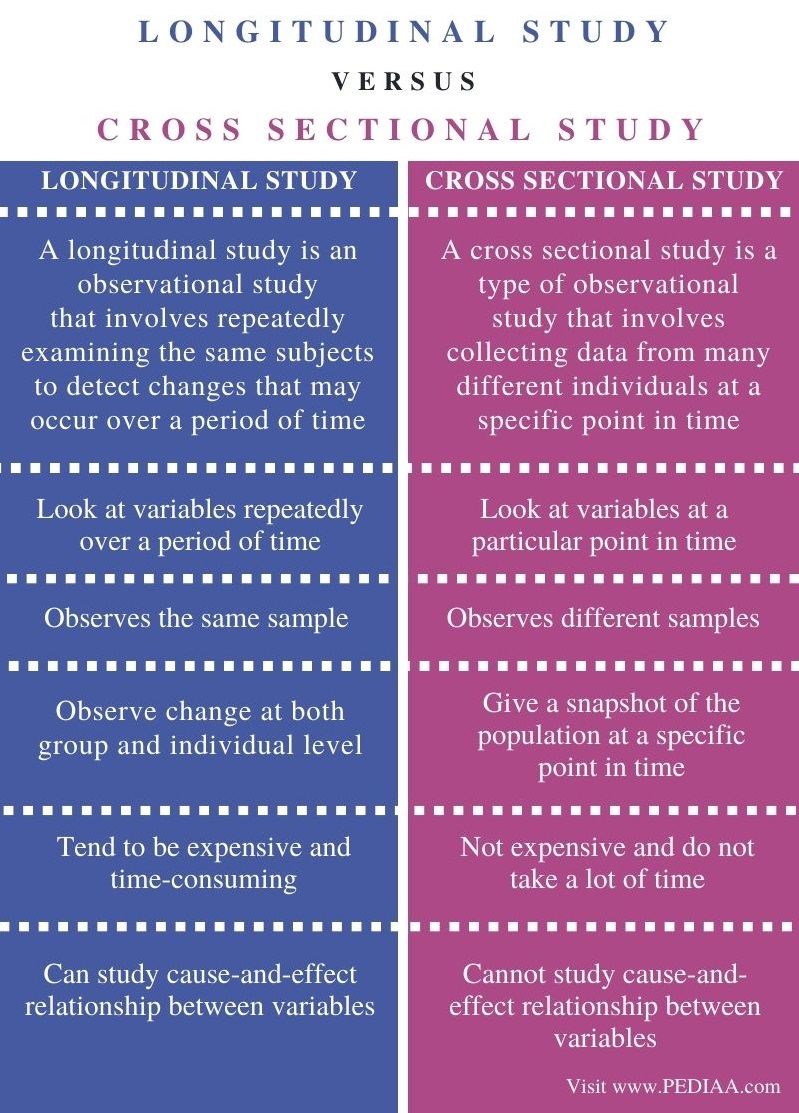Table Of Content

Longitudinal studies and cross-sectional studies are two different observational study designs where researchers analyze a target population without manipulating or altering the natural environment in which the participants exist. Researchers may find that it requires several years of direct observation before any meaningful data becomes available through longitudinal studies. Some relationships or observable behaviors may never occur even though it seems like they should, which means this time investment may never offer dividends. These studies must have the means to maintain continuously open lines of communication with all of the involved parties to ensure that the quality of the data remains high throughout the entire effort. Ensure adequate time is included in project plans for project management and communication with participants.
Retest effects
He used the data to spot trends over the years and understand his colonies' health and economic viability. Longitudinal research refers to any study that collects the same sample of data from the same group of people at different points in time. While time-consuming and potentially costly in terms of resources and effort, a longitudinal study has enormous utility in understanding complex phenomena that might change as time passes.

Ethical issues: researcher related
Longitudinal Study on Dental Status, Caries Risk Assessment, and Oral Health-Related Quality of Life in 3-6-Year-Old ... - Cureus
Longitudinal Study on Dental Status, Caries Risk Assessment, and Oral Health-Related Quality of Life in 3-6-Year-Old ....
Posted: Fri, 26 Apr 2024 10:08:35 GMT [source]
Data collection and analysis should be informed by the research question, data collection methods and theoretical perspective, if one is being used from the outset. It may be possible to anticipate whether cross-sectional or longitudinal analysis would be the most helpful method of answering the research question. Considering these issues at the outset may allow the researcher to be alert to themes in the data during analysis whilst keeping an open mind to emerging issues.
L-Shaped Sofa Layout #2: Nestle into a Window Wall
Over many years, researchers can see both sets of twins as they experience life without intervention. Because the participants share the same genes, it is assumed that any differences are due to environmental analysis, but only an attentive study can conclude those assumptions. Consider a study conducted to understand the similarities or differences between identical twins who are brought up together versus identical twins who were not. The study observes several variables, but the constant is that all the participants have identical twins.
What is an example of a longitudinal study?
The frequency and degree of sampling should vary according to the specific primary endpoints; and whether these are based primarily on absolute outcome or variation over time. Ethical and consent considerations are also specific to this type of research. All effort should be made to ensure maximal retention of participants; with exit interviews offering useful insight as to the reason for uncontrolled departures (3). Participants sometimes drop out of a study for any number of reasons, like moving away from the area, illness, or simply losing motivation. This tendency, known as selective attrition, shrinks the sample size and decreases the amount of data collected.
Longitudinal studies, though, can compare groups either retrospectively or prospectively. Retest effects refer to gains in performance that occur when the same or similar test is administered on multiple occasions. Saul Mcleod, PhD., is a qualified psychology teacher with over 18 years of experience in further and higher education. He has been published in peer-reviewed journals, including the Journal of Clinical Psychology.
Visualize Trends Over Time
The frames are usually wood or metal, while the sofa can be upholstered with cotton, linen, velvet, leather, acrylic, polyester, or polyurethane leather. They also come in any color imaginable - from neutrals to deep blues and greens to vibrant yellows. As the name would suggest, an L-shaped sofa is a couch in the shape of an L. The "L" can either be on the left or right-hand side of the couch, depending on how you want to arrange your space. In this article, we’ll look at what cross-sectional studies are, how it applies to your research and how to use Formplus to collect... In this article, we’ll discuss the effects of selection bias, how it works, its common effects and the best ways to minimize it.
It’s an intelligent way to establish causal relationships within your sample population. People also use them in other medical and social sciences, such as to study customer trends. Researchers periodically observe and collect data from the variables without manipulating the study environment.
One of the central issues we faced in this study was about the nature of time. As discussed above we identified set time points for data collection at the outset. However, we discovered that it is important to balance the pragmatics of a research design with flexible notions of time.
The personal views of the information being collected can also impact the results in ways that are not useful. Longitudinal studies have a robust reliance on the individual interpretations that researchers develop after making their observations. That makes it possible for personal bias, inexperience, or a mistake to inadvertently alter the data being collected in real-time situations. This issue makes it possible for the information to be invalid without researchers realizing that this disadvantage is present in their work. Even if there are numerous people involved with a project, it is possible for a single person to disrupt potentially decades of work because of their incorrect (and possibly inadvertent) approach. For any research project to be successful, there are laws, regulations, and rules that must be instituted from the very beginning to ensure all researchers follow the same path of data collection.
They are beneficial for recognizing any changes, developments, or patterns in the characteristics of a target population. Longitudinal studies are often used in clinical and developmental psychology to study shifts in behaviors, thoughts, emotions, and trends throughout a lifetime. These research studies can last as short as a week or as long as multiple years or even decades.
This type of research is commonly employed to examine the effects of medical treatments on outcomes such as cardiovascular disease or diabetes. The requirements for governmental approval are incredibly stringent and call for rigorous data collection that establishes causality. A personal wellness study, for example, might examine how healthy habits (or the lack thereof) affect health by asking respondents questions about their daily routine. By comparing their routines over time with information such as blood pressure, weight, and waist size, survey data on lifestyle routines can allow researchers to identify what habits can cause the greatest improvement in individual health. There are many other techniques like latent transition analysis, event history analysis, and time series models that have specialized uses for particular research questions with longitudinal data.
In the days, months, years, or even decades that follow, they continually gather more information so they can observe how variables change over time relative to the baseline. Some people may choose to stop participating in the study altogether, which may reduce the validity of the final result when published. It is possible for some individuals or households to shift their demographic profile so that they are no longer viable candidates for the research.

No comments:
Post a Comment